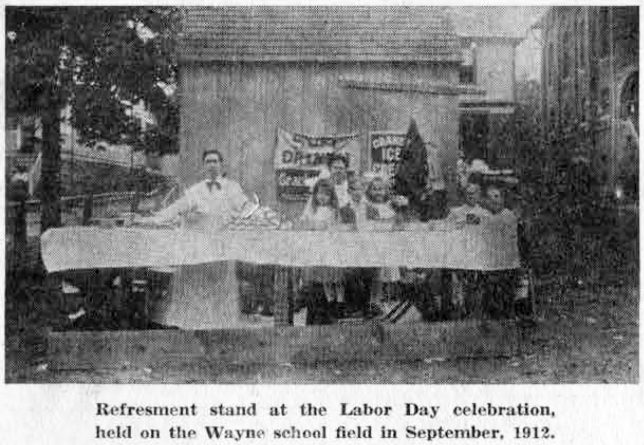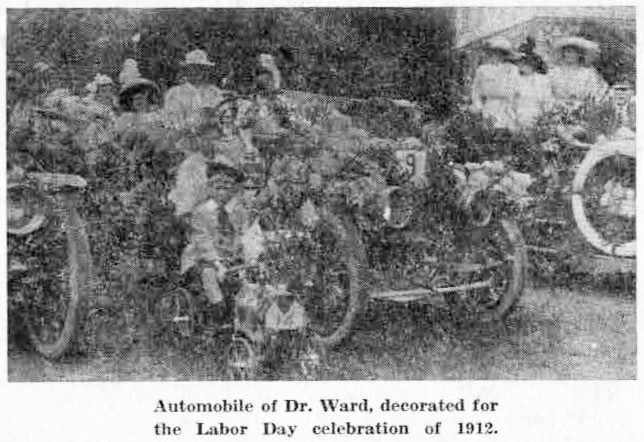 As this columnist reminisced with Otis Hunsicker over a number of old pictures, in preparation for last week’s story on Wayne’s 1912 Labor Day celebration, both recognized at once the man in the picture, shown above, as Philip DeMarse, Wayne’s well-known and popular barber. It is only a few years since Mr. DeMarse retired from active business, after well over 40 years of serving Wayne’s citizens, both as children and as adults. As the writer can full well testify, probably none hold Mr. DeMarse in greater esteem than the mothers of children, with whose antics he always showed such infinite patience.
As this columnist reminisced with Otis Hunsicker over a number of old pictures, in preparation for last week’s story on Wayne’s 1912 Labor Day celebration, both recognized at once the man in the picture, shown above, as Philip DeMarse, Wayne’s well-known and popular barber. It is only a few years since Mr. DeMarse retired from active business, after well over 40 years of serving Wayne’s citizens, both as children and as adults. As the writer can full well testify, probably none hold Mr. DeMarse in greater esteem than the mothers of children, with whose antics he always showed such infinite patience.
This Labor Day celebration of 1912 was also, in its way, a personal celebration for Mr. DeMarse, since it was just four years before, on Labor Day, 1908, that he himself first came to Wayne to make his home and to begin his business career. Born in Italy, he came to America when he was seven years old, first settling with his family in New York and later coming to Philadelphia.
His first job in Wayne was with Clement Grasch, who had a cigar store and barber shop on Lancaster avenue. After that he worked in various locations, the last being a shop in the Anthony Wayne Theatre Building, the ground for which he had sold to Harry Fried for the erection of his motion picture house.
The advertisement on the shed back of Mr. DeMarse seems to show that he was selling Crane’s ice cream and soft drinks to the Labor Day crowds.
Mr. DeMarse has identified the small boy standing between the two little girls as his own son, Francis, now Dr. Francis DeMarse of Chicago. The first woman on Mr. DeMarse’s left is Mrs. Edward Fritz, with her daughter, the other little girl being a niece of Michael McVeigh, the proprietor of the shoe shop then located at the rear of the fire house. While he could not name the woman at the end of the table, Mr. DeMarse believes that the one next to her is Mrs. Lynn Fritz.
The wooden shed, just back of the refreshment stand, was one in which the tire company kept various odds and ends. The fire house, without its present additions, is the building next to the shed, facing on what was then known as Audubon avenue, recently changed to South Wayne avenue. The picture clearly shows the rear door which opened onto the school field, thus giving exits both to the east and west for the fire engines.
Mr. Hunsicker recalls, with amusement, the very early days of the fire company, when the horses to pull the hose reel and combination chemical wagon had to be brought from the stables of the R.H. Johnson Company before the apparatus could get under way.
The building to the rear left of the picture is the old Coffee House, which stood on the approximate site of the present high school gymnasium. The building to the rear right is easily recognizable as Masonic Hall, which now houses the Wayne Red Cross Branch on its first floor.
 The picture shown above is that of the elaborately decorated automobile of Dr. J.M.L.Ward, one of Wayne’s best known citizens, as it was driven in the Labor Day parade by Dr. Ward himself. Of this parade, “The Suburban” of that week said, “What it lacked in numbers, the parade of automobiles made up in the beautifully decorated machines which participated. Trimmed with bunting and festooned with the choicest floral offerings, hydrangeas, scarlet sage, asters, etc., most of the automobiles were veritable bowers of beauty. When all were so charmingly adorned it would seem almost invidious to make special mention of any particular one. There were several unique features, however, that attracted attention. One, especially, was a float on which was seated Dr. Norman Sinclair, Harold Stilwell and Herbert Lienhardt, representing respective political candidates, Woodrow Wilson, Colonel Roosevelt and President Taft. Another machine which created the greatest amusement was that driven by Douglas Wendell. On the front of it was a gigantic moose head typifying the Bull Moose party. Seated in the auto in addition to the driver, who was dressed as Uncle Sam, was George Long, who gave an excellent characterization of the strenuous Teddy; and Huber Stilwell, who was simply great in his take off of the Common People, the famous cartoon character that Herbert Johnston exploited in the ‘North American.’ ”
The picture shown above is that of the elaborately decorated automobile of Dr. J.M.L.Ward, one of Wayne’s best known citizens, as it was driven in the Labor Day parade by Dr. Ward himself. Of this parade, “The Suburban” of that week said, “What it lacked in numbers, the parade of automobiles made up in the beautifully decorated machines which participated. Trimmed with bunting and festooned with the choicest floral offerings, hydrangeas, scarlet sage, asters, etc., most of the automobiles were veritable bowers of beauty. When all were so charmingly adorned it would seem almost invidious to make special mention of any particular one. There were several unique features, however, that attracted attention. One, especially, was a float on which was seated Dr. Norman Sinclair, Harold Stilwell and Herbert Lienhardt, representing respective political candidates, Woodrow Wilson, Colonel Roosevelt and President Taft. Another machine which created the greatest amusement was that driven by Douglas Wendell. On the front of it was a gigantic moose head typifying the Bull Moose party. Seated in the auto in addition to the driver, who was dressed as Uncle Sam, was George Long, who gave an excellent characterization of the strenuous Teddy; and Huber Stilwell, who was simply great in his take off of the Common People, the famous cartoon character that Herbert Johnston exploited in the ‘North American.’ ”
(To be continued)
